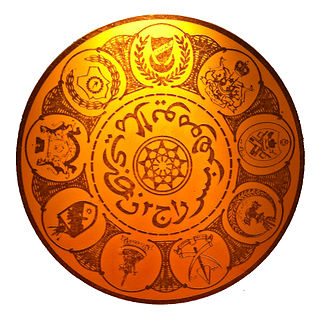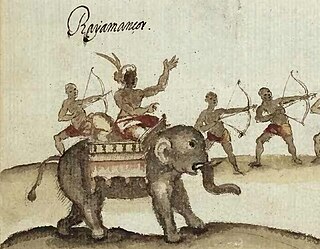Related Research Articles
Maharaja is an Indian princely title of Sanskrit origin. In modern India and medieval northern India, the title was equivalent to a prince. However in late ancient India and medieval south India, the title denoted a king.

The Johor Sultanate was founded by Sultan of Malacca Mahmud Shah's son, Alauddin Riayat Shah II in 1528.

Bendahara was an administrative position within classical Malay kingdoms comparable to a vizier before the intervention of European powers during the 19th century. A bendahara was appointed by a sultan and was a hereditary post. The bendahara and the sultan shared the same lineage.
Sultan Alauddin Riayat Shah ibni Almarhum Sultan Mansur Shah was a sultan of the Malacca Sultanate from 1477 to 1488.

The Sultanate of Deli was a 1,820 km2 Malay state in east Sumatra founded in 1632 when a commander of the Aceh Sultanate, Gocah Pahlawan, conquered the area during the reign of Iskandar Muda. A tributary kingdom from 1630 it was controlled by various sultanates until 1814, when it became independent and broke away from the Sultanate of Siak.

Sultan of Pahang is the title of the hereditary constitutional head of Pahang, Malaysia. The current sultan is Al-Sultan Abdullah ibni Sultan Ahmad Shah. He is the Head of Islam in the state and the source of all titles, honours and dignities in the state. Historically, the title was also used by rulers of the Old Pahang Sultanate.

The monarchies of Malaysia exist in each of the nine Malay states under the constitutional monarchy system as practised in Malaysia. The political system of Malaysia is based on the Westminster parliamentary system in combination with features of a federation.
Sri Maharaja Sang Sapurba Paduka Sri Trimurti Tri Buana, (1245–1316) also known as Sri Nila Pahlawan, is a figure in the Malay Annals, highly revered as the legendary great ancestor of some of the major dynasties of the Malay world: Singapura, Malacca, Pahang, Johor, Perak, Kelantan, Terengganu and Siak Sri Indrapura. Legend has it that after his accession to Seguntang Hill with his two younger brothers, Sang Sapurba enters into a sacred covenant with Demang Lebar Daun the native ruler of Palembang, which laid the basis of the proper relationship between the Malay rulers and the subjects. The legendary sword believed to be carried by the king, the Cura Si Manjakini, is now formed part of the regalia of Perak Sultanate, whose rulers are said directly descended from the king. The details of Sang Sapurba stories are mainly composed of folklore and legends, and thus his historical existence is debated and disputed by modern historians. Even so, as De Jong argued in her article The Character of Malay Annals, the stories of the Malay Annals could have been realistically mixed with the historical figures and events.

Sultan Alauddin Mansur Syah was the eighth Sultan of Aceh in northern Sumatra. He ruled Aceh from 1579 to 1585 or 1586 and was known as a pious Muslim ruler with cultural interests. His reign also saw some military expansion on the Malay Peninsula. With his death ended a 65-year long period of warfare between Aceh and the Portuguese.
Sultan Muhammad Shah ibni Almarhum Sultan Mansur Shah (1455–1475) was the founder of the old Pahang Sultanate and reigned from 1470 to 1475. A former heir apparent to the Malaccan throne, he was banished by his father Mansur Shah for committing murder, following an incident in a Sepak Raga game and went into exile in Pahang and was later installed as its first sultan in 1470.
Sultan Zainal Abidin Shah ibni Almarhum Sultan Mahmud Shah was the seventh Sultan of Pahang and reigned from 1540 to 1555. He succeeded his elder brother Sultan Muzaffar Shah on his death in 1540.

The Pahang Sultanate also referred as the Old Pahang Sultanate, as opposed to the modern Pahang Sultanate, was a Malay Muslim state established in the eastern Malay Peninsula in the 15th century. At the height of its influence, the sultanate was an important power in Southeast Asia and controlled the entire Pahang basin, bordering the Pattani Sultanate to the north and the Johor Sultanate to the south. To the west, its jurisdiction extended over parts of modern-day Selangor and Negeri Sembilan.

The Bendahara dynasty is the current ruling dynasty of Pahang, Terengganu and Johor – constituent states of Malaysia. The royal house were of noble origin, holding the hereditary position of bendahara in the courts of Singapura, Malacca and Old Johor since at least from the end of the 13th century.
Paduka Sri Sultan Mansur Shah I ibni Almarhum Sultan Muzaffar Shah I was the second Sultan of Perak. He was the son of Sultan Muzaffar Shah I and Tun Terang, daughter of Tun Fatimah and Tun Ali.
Paduka Sri Sultan Ahmad Tajuddin Shah ibni Almarhum Sultan Mansur Shah I was the third Sultan of Perak. He was the son of the second Sultan of Perak, Mansur Shah I.
Paduka Sri Sultan Mukaddam Shah was the sixth Sultan of Perak. He is the son of the sister of Sultan Ahmad Tajuddin and Sultan Tajul Ariffin Shah, and was the cousin of Raja Kecil Lasa Raja Inu. Before becoming Sultan, he was known as Raja Tua.
Paduka Sri Sultan Mahmud Shah I was the eighth Sultan of Perak. He was the brother of Alauddin Shah and Mansur Shah II, and grandson of Sultan Ahmad Tajuddin Shah
Sultan Muzaffar Shah II ibni Almarhum Raja Mahmud was the tenth Sultan of Perak reigning from 1636 to 1653. He was the first Sultan of Perak to come from a different dynasty from the first nine Sultans of Perak. His paternal grandmother, Raja Putri Putih, was the daughter of Sultan Mansur Shah II of Pahang.
Sultan Mahmud Iskandar Shah ibni Almarhum Sultan Muzaffar Shah II was the eleventh and longest-reigning Sultan of Perak reigning from 1653 to 1720. He was the son of Sultan Muzaffar Shah II and Raja Putri Fatima Putih, granddaughter of Sultan Abdul Ghafur of Pahang.

The Conquest of Perak was a military invasion launched by the Acehnese Sultanate to capture the port of Perak from its Sultan Mukaddam Shah of Perak, the attack was successful and its sultan was captured.
References
- 1 2 Jeragan, Abdul Shukor (June 1907). "List of Graveyards of the Late Sultans of the State of Perak, Der-Ul-Rithuan, enquired into and visited by me, Stia Bijaya Di Raja, under instructions received from the Government". Journal of the Straits Branch of the Royal Asiatic Society (48): 99. ISSN 2304-7534.
- 1 2 3 4 5 Jasbindar, Freddie Aziz. "Sultan Mansur Shah II (Sultan Perak ke 7)". www.orangperak.com. Retrieved 2022-09-02.